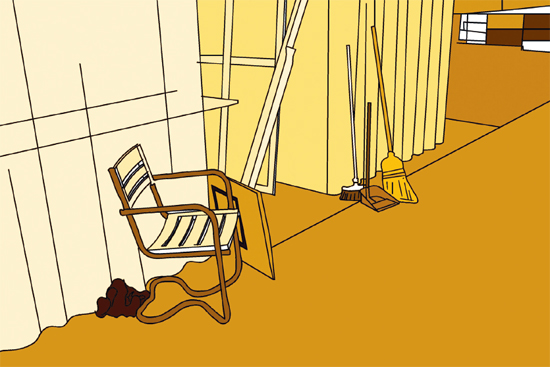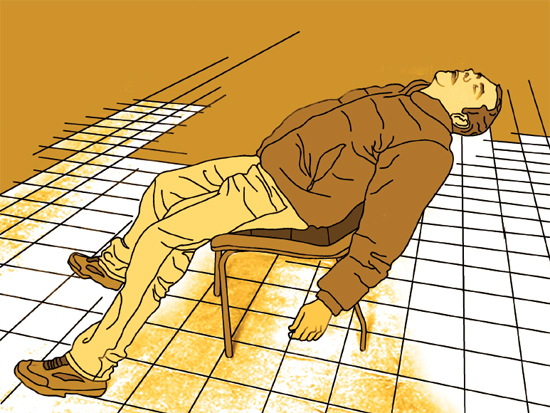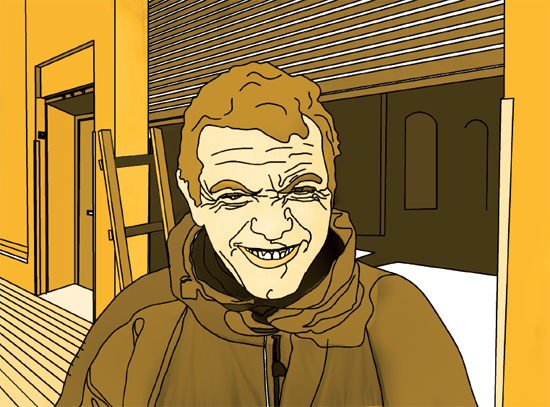Welcome, Mr. Architecture. This is our workshop. Let me take off your coat. I am very glad that You are here.
We have just moved in so I cannot show you too many things. The hall is almost empty but we have transported a few things from our old place. There was a little fuss about what is garbage and what is not. Should we take this or that? Would it be good for something or not? You never know what happens tomorrow. We threw away a lot of things. Maybe too many. It happens all the time that you would need something but you have already thrown it away. This is how it goes…

“We have just moved in so I cannot show you too many things.”
We love to fix things. Come! Do you see this shelf? We cleaned it up this week with gasoline. It looks like it is brand new, its screws are twinkling. If I just told you what kind of things were on it! You would have felt like you wanted to throw away the whole thing. We found some rasp stuck in the machine oil as we were looking it through; they are now soaking in the coke bottle. Coke is the best detergent for something like that. It takes everything out. There is a flea market nearby; you can buy there handles for pennies. We make them new in a moment.
This room on the right is still empty so we store some useful things here. Some furniture, interesting things, silly things. There is for example a stone basin with mosaic. It is a very pretty piece. Some of the mosaic pieces are cracked but that can be fixed easily. It belonged to a barbershop. It would have ended up in the trash if we had not taken it under our wings. It is a bit heavy, but that does not matter, we brought it here. We have a crane. One day it will find its own place; maybe a generous client will adopt it. People like these things. Do you see this weird chair? It looks like it is ruined, doesn’t it? But that is not the case. It is redesigned. Its backrest was curved back and its legs were adjusted to the it in order to protect the person from falling on his back. It could belong to a lazy accountant. It is suitable for relaxing in the office. You can lie down on it. It is almost a sofa.

“It probably belonged to a lazy accountant.“
Of course you, architects look at these things differently. You call it recycling and you have other ways to do it. Garbage really has to hit the bull’s-eye to become design. For you, repairing is out of question. But these treasures are invaluable. Think about it! Each of them has its own story that makes it unique. How can I say? You can dust old things, but you cannot add an extra layer of dust on new ones. Time does the job. We are in the store room. There is some chaos in here. We love chaos. Everyone has their own little things and treasures at their disposal. Things go around, come around. A lot of them come on their own feet, they simply appear and we just use them or store them. The space therefore gets filled up.
There comes a moment quite regularly when we have to let go of things. These are hard moments. You stop and look at the garbage, wait and think; usually with no use.
This is somehow connected to the hours spent in the workshop. The hits with which we transform the material, transform us as well. Knowledge and experience strengthens us and makes us confident. You become more and more convinced that things are useful and once can even save lives. Therefore – as time goes on – scrapping gets harder and harder. And we get scared, too.
If something is missing, you immediately think that someone has thrown it away…
Broken tools are the biggest challenge. Tools are not only things, they are work equipments. A tool – even if it is nicked – is still good. You can still use it for tightening, cutting, drilling, etc. And it can be fixed, usually. It will never be the same as a brand new one, but never mind. In this box you can find the tools waiting to be fixed. We just call it the elephants’ graveyard.

“He is a serious collector. We are only amateurs.”
Come, I will show you the parcel of my retired colleague. He is a serious collector. We are only amateurs. Here are the tables. This – on the left side – belongs to him. We call him Maestro. Look at these tiny boxes full of little screws and things. A single box can be like 20 kg. Treasure boxes in which you can find anything you need. You just dip into it and you reach immediately “The thing” or something similar.Fast and precisely. Just like you were shopping in a Swiss hardware store. You only have to transform it a little bit. There is something magical and unbelievable in that; but we never ask, just use it. Of course we are also part of this balance – at least our head is. We overcome things’ defects with our ideas. We keep collecting and searching in the accumulated things. Maestro is a bit different. He has Diogenes syndrome. He wouldn’t throw away anything; he fixes everything with the help of his collection. But after all, we try to control him. There are quarrels; this is my garbage, don’t touch it, don’t throw it away, it could save lives. Until now we could not decide who the biggest “accumulator” is; we only make accusations. We all agree on the fact that balance is important. This is like the zen. We should find the balance between Diogenes-syndrome and the elephants’ graveyard.
You should stick to non-affection, otherwise things thicken, space is used up and the machine stops.
I understand You, Mr. Architecture that you have to go and get an Aspirin. I am very glad that you stopped by. You are welcome here anytime. Please come. We will teach you how to weld and to put simple furniture together. You will see how much fun that is. We always have a desk for You to clean. It would be amazing. I thank you again that You stopped by, goodbye. Goodbye!